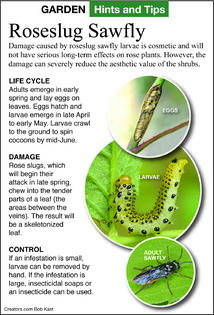The Greener View: Daylily Fungus and Roseslugs
Q: My daylilies are usually beautiful, but they already have long stripes of yellow and dead areas on the leaves. I looked for insects but didn't see any. I don't think I over fertilized, but I don't know what else to look for.
A: The most likely problem is a simple fungus disease called daylily leaf streak. The first thing you might see is small oval dead and dying spots. Next, the central veins of the leaf turn yellow, and eventually, the whole leaf dies. The disease shows up in areas that stay wet during the cool seasons. Sometimes the weather keeps the plant wet, and sometimes it is an irrigation system. Daylilies in lots of shade and near a source of water, such as a swimming pool splash zone, have a better chance of developing fungal problems.
There are some varieties of daylily that are resistant. To prevent the disease, you need to use fungicides before the problem develops. Remove all the infected leaves and destroy them. Tools, gloves and other things that come in contact with the infected leaves can spread the disease.
Another daylily problem is called daylily rust. It also forms dead and dying streaks on the leaves, but they are longer, more obvious streaks instead of oval spots. This disease releases dusty orange fungal spores on the bottom of the leaf. Anything brushing up against them will turn orange. This disease was first found in the United States in 2000, but it can't survive northern winters, so is only found in the southern states.
Q: Something is eating half of my rose leaves. It leaves a paper-thin layer on the leaf, but it eats the rest. I saw a slug on the leaf, but this doesn't look like slug damage to me.
A: It sounds like your roses have roseslug sawfly larvae. They eat the layers of a leaf but sometimes leave the top. The layer that is left is so thin you can see through it. Many times, they eat the leaf and just leave the veins. The adult is a small wasp that hatches from the pupa in the spring to lay eggs in the rose leaves. The female has a sawlike ovipositor that inserts the eggs into the leaf.
The small larvae are covered in a wet slime, so they look like slugs. They are kind of clear-looking, and you can see inside to the rose leaf they are digesting, so they are the same color as the leaf and are often hard to see. As they get larger, they look like a caterpillar, but they don't turn into moths or butterflies.
Usually, there are not too many and no control is necessary. If there are lots visible on the roses, just take a gloved hand and squish them or use a garden hose to wash them off the plants. Slug baits won't work as they are not slugs, and Bacillus products only work on caterpillars of moths and butterflies, so they won't work either. Typical insecticides labeled for roses will work, if required.
========
Email questions to Jeff Rugg at info@greenerview.com. To find out more about Jeff Rugg and read features by other Creators Syndicate writers and cartoonists, visit the Creators Syndicate website at www.creators.com.
Copyright 2024 Jeff Rugg. Distributed By Creators.







